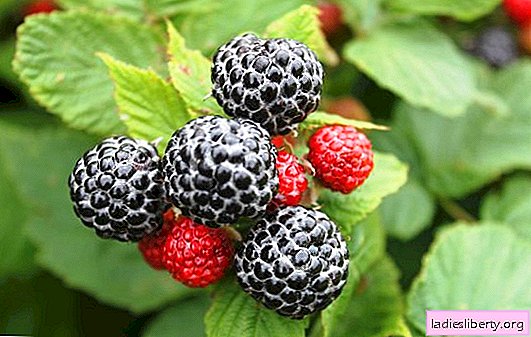
One of the dangerous diseases of fruit trees caused by the bacteria Erwinia Amilovora is called a bacterial burn or ognevitsa.
For the first time, outbreaks of this ailment were recorded back in the 18th century in North America.
During the sale and transportation of seedlings of fruit plants, a bacterial burn was widespread throughout the world.
This disease is insidious in that often inexperienced gardeners often take its symptoms for manifestations of other infections and do not take appropriate measures in time:
• due to the fact that the burn develops on the plant from top to bottom, it happens that it is found on adult tall trees when the tree is already half damaged;
• the initial withering of the crown of the tree is considered a consequence of a lack of moisture and increase watering, accelerating the development of the disease;
• often a bacterial burn is confused with bacterial cancer (these diseases can be distinguished by conducting clinical studies of samples of infected tissues).
All parts of the fruit tree are affected by this infection, but most of all, flowers, young shoots of the current year, and ovaries.
How does the disease develop?
The rate of pear damage by a bacterial burn depends on the following factors:
• tree age (more often young seedlings are affected);
• pear varieties;
• soil on the site (increased nitrogen content in the earth increases the development of burns);
• climatic conditions (increased humidity and air temperature are the most favorable for disease progression).
Primary infection occurs in the spring during pear flowering. Bacteria over long distances from infected plants, bacteria are carried by insects, birds, wind, rainwater. Once on the flowers, bacteria begin to multiply actively and spread inside the plant, affecting young shoots, branches, and the trunk.
Also, infection can occur through damaged tree bark, wounds on the leaves.
Secondary infection occurs in the summer, when a viscous exudate containing a large number of bacteria begins to stand out from cracks in the trunk and branches of a tree. In the open air, it is stretched in the form of thin threads and is easily carried by the wind. Less commonly, infection occurs through garden tools or during vaccination.
Symptoms of a pear bacterial burn (photo)
The disease has the following symptoms:
• delayed opening of the kidneys, and then their blackening (at the same time they do not fall, but remain on branches);
• blackening, wilting and drying of flowers (if infection occurred during flowering);
• blackening and twisting of shoots, leaves.
• reddish-brown stains on the cortex, viscous milky exudate stands out from the cracks;
• Affected wood tissues swell and exfoliate (this is the last stage - the tree is dead).
As a result, the pear tree looks charred (hence the name of the disease).

Signs of a pear bacterial burn
Diagnosis of a bacterial burn
The ability to save a pear tree and the garden as a whole depends on timely diagnosis of the disease. To determine the causative agent in the laboratory, bacteriosis is carried out on the tissues of the infected tree (shoot tips, tree bark, fruits).
When treating a bacterial burn, the timely detection of the disease is important. There are several methods to combat this infection, each of which has its pros and cons.
Chemical method
In the initial stage of the disease, you can try to treat with copper-containing drugs. A mixture of 1% solution of copper sulfate with milk of lime has a pronounced antibacterial effect. It is important not to overdo it with the amount of vitriol - its excess causes a burn of leaves. You can also use drugs with a copper content such as Abiga Peak, Rovral, Skor, Oksikhom and others. Spraying the affected trees is carried out five times:
1. period of swelling of the kidneys;
2. blooming leaves;
3. after flowering;
4. 2 weeks after the last treatment;
5. after harvesting.
If no improvement has occurred, then the bacteria have developed resistance to this fungicide. In this case, it is advisable to cut and burn the affected parts of the tree and carry out antibiotic treatment.
Radical method
This method is applicable if symptoms of a bacterial burn are detected on one of the fruit trees in the area. It is better to destroy the infected plant in order to protect the remaining plantings from infection. Better to sacrifice one tree than to lose the whole orchard. If the lesion area is small (less than 30%), then you can remove the diseased areas, cutting even healthy tissue 0.2-0.4 m below the affected tissue. In this case, all sections are treated with a solution of copper sulfate (1% -100 g of powder per 10 l of water) or iron sulfate (70 g per bucket of water). For disinfection of the instruments used, after each cut, use such solutions as: copper sulfate (5%), iron sulfate (8%), dichloramine (1%), potassium permanganate (1%). Burning blades in a fire does not completely destroy the infection.
All trimmed parts of the tree should be burned immediately, preventing the leaves from flying apart. Harvesting and storing firewood from infected branches and trunks of a pear is not permissible, otherwise the infection will quickly spread to all plantings.
Antibiotics
The use of antibiotics is the most effective way to treat a pear bacterial burn. For this, streptomycin is used. An ampoule (500 thousand units) is bred in 5 liters of water and the affected trees are sprayed. The first treatment is carried out in June (during the active growth of shoots), then every three weeks. If between the treatments it rained or the weather was hot, then the trees are sprayed again. Additionally, stimulants (Zircon, Immunocytophyte, etc.) are used to increase the immunity of pear trees.
Bacteria tend to mutate and develop resistance to the antibiotic used, so every year you need to change drugs. Well proven in the fight against a bacterial burn:
• tetracycline (2 tablets per 3 liters of water);
• ofloxacin;
• gentamicin (2 mg (1 ampoule) is diluted in 1 liter of water).
On a note! When using any drug, it is necessary to process the whole tree from the top of the head to the very bottom of the trunk, as the disease "descends" down the table to the root system.
Bacterial burn prevention
Infection of the orchard with a bacterial burn can be prevented if the following prophylaxis is carried out in time:
• observe the cleanliness of plantations - weeding weeds (many wild plants are incubators of the causative agent of this disease) and the destruction of wild fruit trees (especially hawthorn);
• spraying plantings with drugs against various diseases that weaken the immunity of trees;
• control of insect pests that transmit infections between plants;
• cultivation of varieties resistant to bacterial burn;
• acquisition of seedlings in proven nurseries;
• disinfection of garden tools when pruning trees;
• regular inspection of orchards will detect the disease at an early stage and take timely measures;
• winter control of suspicious seedlings: twigs are cut from marked specimens, placed in water at room temperature and wait for buds to open. The conclusions about the presence or absence of infection are made according to the state of emerging leaves.











